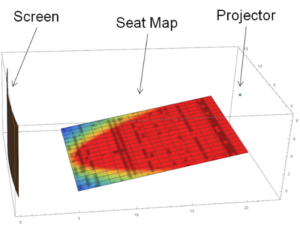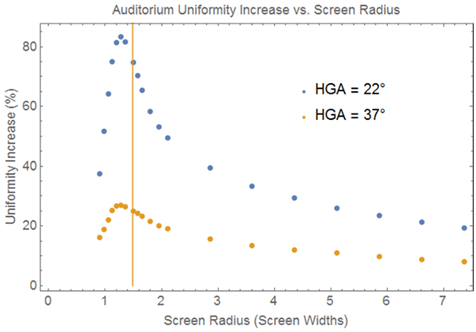The cinema industry is currently actively debating how laser phosphor and RGB laser light sources will be adopted in cinemas. In one corner is Christie, which has said that laser phosphor light source are transitional and that by 2022, all new cinema projectors will be powered by RGB laser light sources. In the other corner is Barco which is saying that laser phosphor projection has a place in cinemas and will continue to have a place for some time to come – well beyond 2022.
In a Barco presentation at Display Summit China, speakers Bill Beck and Robin Xu extolled the benefit of an all laser solution – that includes a mix of laser phosphor (LP) and RGB laser light sources. Barco sees RGB as serving the Premium Large Format (PLF) segment of the market where the biggest screens and the highest image quality are need. These remain expensive solutions today, but they will come down in price – just not as fast as Christie believes.
For the mainstream part of the market, LP makes sense as the solution is much lower cost than RGB and there are significant total cost of ownership (TCO) benefits that exhibitors can take advantage of now. “2017 Barco LP models will accelerate this adoption,” noted Beck.
He showed two summary slides on the technology strengths and benefits of these two technologies, as shown below.
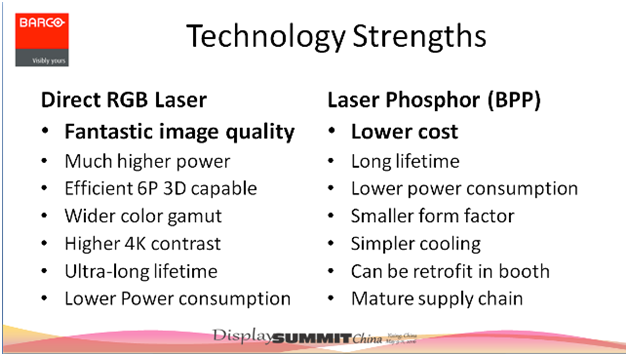
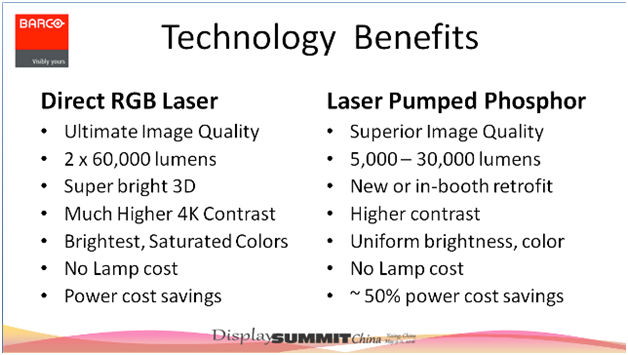 Barco sees multiplexing moving to “all-laser” solution meaning a mixture of RGB and LP screens. In fact, they already have their first exhibitor ready to do this – the Jinyi HaiZhuCheng 13 screen multiplex and the Santikos flagship multiplex which will go all RGB with 18 screens. The rest of the circuit or more than 140 screens will get a mix of LP and RGB.
Barco sees multiplexing moving to “all-laser” solution meaning a mixture of RGB and LP screens. In fact, they already have their first exhibitor ready to do this – the Jinyi HaiZhuCheng 13 screen multiplex and the Santikos flagship multiplex which will go all RGB with 18 screens. The rest of the circuit or more than 140 screens will get a mix of LP and RGB.
Dolby’s VP of Cinema Image Engineering, Pete van Kessel, noted that the new Dolby Cinemas are part of the PLF market segment and that this segment grew 27% in 2015 from 1650 screens to 2097. This represents about 1.5% of the total cinema screen market and he thinks there is a lot of room for growth.
He then went on to describe some details of the Dolby Cinema experience but revealed a few specs we were not aware of before. For example, Dolby targets a 1% reflectance target from the theater by proper choice of materials so they can get a 0.001 nit black level measurement. With typical theatrical content at around 7-10% average picture level, contrast in the theater is about 100,000:1. But for very dark content with an APL of only 1%, the contrast rises to 1M:1.
Barco and RealD have done modeling on the contrast of theaters and how that impacts the need for high native contrast in the projector. They found that for typical movie content, projector contrast in the range of 10K to 20K:1 is adequate. But for darker content, you need the higher contrast of the Dolby Cinema projector solution, which is thought to have a native projector contrast in the 1M:1 range.
The Dolby Cinema is also high dynamic range capable, but all the participants said there is no agreed upon definition of the contrast needed to create an HDR theater. Van Kessle then showed a nice chart that indicated all of the areas that Dolby has been active in to develop the full HDR ecosystem. It is a very impressive array of activities that is yielding the roll out of HDR solutions now – both professional and consumer. They have been at this for 10 years!
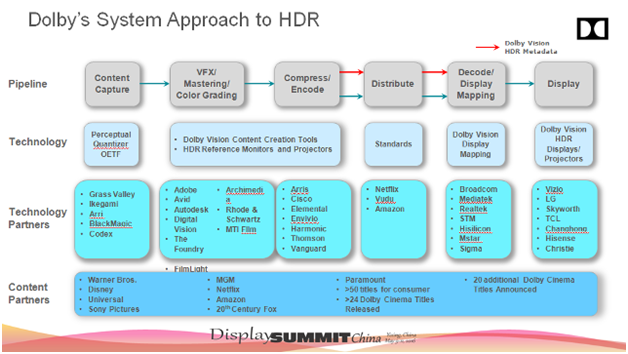 He then detailed successes with Dolby Cinema: 24 working cinemas, with 70 planned for the end of 2016; 200 screens announced so far. And the studios are mastering the content for these screens.
He then detailed successes with Dolby Cinema: 24 working cinemas, with 70 planned for the end of 2016; 200 screens announced so far. And the studios are mastering the content for these screens.
Dave Coleman of RealD gave an overview of proper screen design looking more closely at what the screen does in terms of hot spots and uniformity but also stereo contrast and viewing angle. RealD has developed an ‘Ultimate Screen’ which offers marked performance increases, so the presentation helped provide the analysis to support this claim.
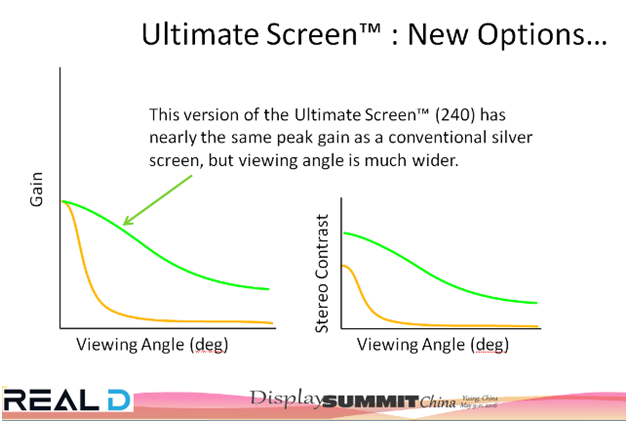 To improve brightness uniformity in a cinema, the screen is often curved. But according the Coleman, no one has ever really done an analysis to determine the best curvature for a given throw ratio. He did this and provided many slides showing results and various methods to measure brightness uniformity. After evaluating several methods, he decided that plots of the median brightness at every seat in the cinema was the best metric.
To improve brightness uniformity in a cinema, the screen is often curved. But according the Coleman, no one has ever really done an analysis to determine the best curvature for a given throw ratio. He did this and provided many slides showing results and various methods to measure brightness uniformity. After evaluating several methods, he decided that plots of the median brightness at every seat in the cinema was the best metric.
The result? When transitioning from a flat to a curved screen, the front middle section sees a 100% increase in brightness uniformity, while all the middle seats see at least a 60% increase in brightness uniformity. The sides of the auditorium don’t see much improvement – only 3%, so don’t sit there.
Finally, Coleman determined the optimal curvature based upon the throw ratio. For a conventional screen with a half gain angle of 22-degrees, the optimal screen radius is equal to the throw ratio when the throw ratio is 1.0. For higher throw ratios, the optimal curvature is slightly less than the throw ratio.
He then compared the benefits of curvature for a standard silver screen with a half gain angle of 22-degrees and the RealD Ultimate screen with a half gain angle of 37 degrees. The results, shown in the chart below, indicate a greater benefit from curving a 22-gain screen than the Ultimate screen.

